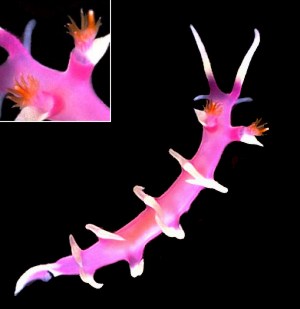
Marianina rosea
(Pruvot-Fol, 1930)
Order: NUDIBRANCHIA
Suborder: DENDRONOTINA
Family: Marianinidae
DISTRIBUTION
Tropical Indo-West Pacific.
PHOTO
Îlot Maître, Nouméa, New Caledonia. 24 October 1988, inside reef crest, 11mm long. PHOTO: Bill Rudman.
This small dendronotoidean is often found under dead coral slabs on reef flats. It feeds on hydroids. Its colour, and row of bifid cerata down each side of the mantle are characteristic of the species. It is sometimes referred to under the later name Aranucus bifidus Odhner, 1936.
Reference;
• Pruvot-Fol, A. (1930). Diagnose provisoires (incomplètes) des espèces nouvelles et liste provisoire des mollusques nudibranches recueillis par Mme. A. Pruvot-Fol en nouvelle Calédonie (Ile des Pins). Bulletin Muséum National d'Histoire Naturelle Paris, series 2, 2(2): 229-232.
Rudman, W.B., 2000 (June 24) Marianina rosea (Pruvot-Fol, 1930). [In] Sea Slug Forum. Australian Museum, Sydney. Available from http://www.seaslugforum.net/find/marirose
Related messages
Marianina rosea from Saipan, Marianas Ids
November 1, 2005
From: Yuji Fujie
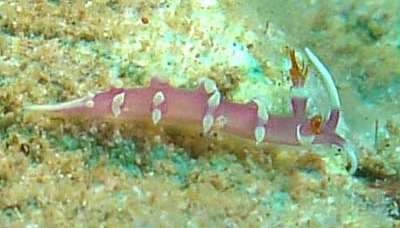
Dear Sirs,
I think this is possibly as young Flabellina exoptata?
Would you tell me real name ?
Locality: LauLau Beach, Saipan, Northern Mariana Islands. Depth: 12 m. Length: 5 mm. 26 October 2005. Rock. Photographer: Yuji Fujie
Yuji Fujie
dswith@isletwind.com
Yuji Fujie, 2005 (Nov 1) Marianina rosea from Saipan, Marianas Ids. [Message in] Sea Slug Forum. Australian Museum, Sydney. Available from http://www.seaslugforum.net/find/15127Dear Yuji,
This is Marianina rosea. One way to tell it is not an aeolid such as Flabellina is to look at the shape of the rhinophores. Marianina rosea is a tritoniid and in that family the rhinophores have a ring of vertical papillae which form a circle around the central stalk, as in your photo. Although the name Marianina sounds appropriate for something from the Mariana Islands, the similarity is a coincidence as this species was first described from New Caledonia.
Best wishes,
Bill Rudman
Can somebody id this for me please ?
March 8, 2005
From: Andy Hiam
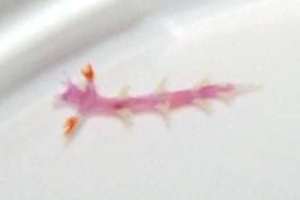
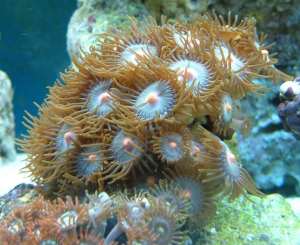
If somebody could id this for me please that would be great as i cant find it in the species list !
I'm sorry I can't supply any information about it apart from it being approximately 5mm long. I am a newcomer to tropical marine keeping ( my first tank setup )and i found it on a small patch of polyps ( zooanthids )picture enclosed !
Andy Hiam
Dear Andy,
From what I can see of your photo I am pretty sure this is Marianina rosea. We don't know very much about its biology apart from it being small, seldom more than 1 cm in length. The group of nudibranchs it is related to - the Dendronotina - are mostly cnidarian feeders, some, such as the tritoniids, feeding on soft corals, and others, such as the dotids and bornellids, feeding on hydroids. Perhaps your observation means that Marianina feeds on zoanthids. It would certainly be interesting to check. I hope you will be willing to risk your zoanthid colony and keep the little nudibranch in your aquarium and see what it does. Even if it does eat the zoanthid, the size difference should ensure it doesn't do much damage - and you could be making a scientific discovery
Best wishes,
Bill Rudman
Marianina rosea from South Africa
June 25, 2000
From: Valda Fraser
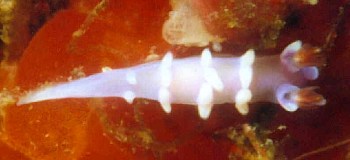
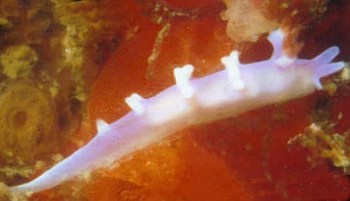
Dear Bill
I wonder what this one is? Can you help? Thank you.
Locality: Park Rynie - 36m - south coast KwaZulu-Natal SOUTH AFRICA
Date: June 2000
Size: 10mm
Regards
Valda Fraser
iti04937@mweb.co.za
Fraser, V., 2000 (Jun 25) Marianina rosea from South Africa. [Message in] Sea Slug Forum. Australian Museum, Sydney. Available from http://www.seaslugforum.net/find/2603Dear Valda,
This is a pretty little dendronotoidean called Marianina rosea. Although your specimens are of similar size to the one in the photo at the top of the page, the shortened oral tentacles and cerata, suggest your animals are juveniles.
The cerata are in fact a pair of cerata with a common stalk. It is found throughout the tropical Indo West Pacific but has seldom been reported, probably because of its small size.
Best wishes,
Bill Rudman.
